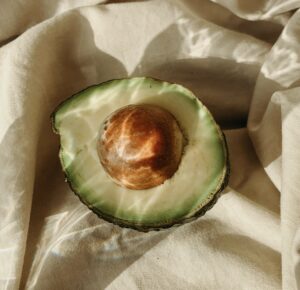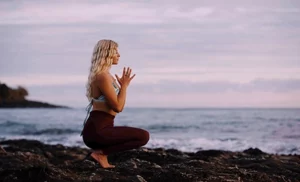

Ayurveda for Autumn/Winter | Adventure Yogi
Ayurveda in Autumn – advice to stay balanced
Autumn is predominantly a cool season when Vata dosha dominates inside and outside our bodies. Vata is predominant in the elements air and space, giving it cold, light, dry, rough, and moving qualities. This quality of movement makes Vata the most powerful dosha, capable of aggravating Pitta and Kapha when unbalanced. As Autumn is a time when we are especially vulnerable to Vata aggravation we must take more care. Signs of out of balance include bloating and gas, dry skin, constipation, irregular appetite, lack of sleep, stress and tiredness. Luckily, there are lots of ways to use Ayurveda in Autumn to help keep the balance.
To balance Vata, focus on a diet and lifestyle that predominant in qualities opposite. Three key words are grounding, warming and routine. For example, warming, nourishing, and moisturising factors offset its coldness and dryness; routine and stillness offsets its quality of movement. It’s important to balance Vata all year round, especially if it is your dominant dosha. However, we all need to pay attention to Vata in Autumn.
Here are some more tips to stay balanced using Ayurveda in Autumn and early Winter:
1. Focus on a warming, nourishing diet.
A diet rich in oils and ghee, with spices such as ginger and cumin. Have a warm breakfast (porridge, stewed apple, quinoa pancakes), followed by soups, stews, chapattis, kichadi (one pot rice and dhal meal) and lots of warm herbal teas. End the day with warm milk with ginger, nutmeg and a little honey to help you drift off. Vata is increased by astringent, bitter and pungent flavours so avoid consuming an excess of these tastes such as raw food, dry muesli, chickpeas, peas, popcorn, caffeine and sandwiches. Minimise all dry, rough, cold food. Iced food and drinks are never great but be especially careful to avoid them during Autumn.
2. Take extra care of your skin due to Vata’s drying nature.
Ground yourself with a daily self-massage with a warm sesame oil self-massage. Start with the soles of the feet and work up the body to the head in sweeping strokes along muscles, and circular movements around joints. Always massage the belly in a clockwise direction- up the right side and down the left side. Leave the oil on for 10 minutes then shower/ bathe. A daily massage also helps dilate the skin surface, clear toxins and aid movement of lymph. Try the nourishing Autumn face mask recipes below too!
3. Keep to regular meal times
With lunch as your main meal, and a smaller dinner, eaten as early as possible. Try to get up and go to sleep at regular times as well. Also, this is a good time to introduce regularity at your work place by having regular breaks, sipping herbal teas throughout the day and not working yourself too hard.
4. Increase stillness in your day
Time to connect with yourself. Vata is aggravated by feelings of fear and insecurity so take the time to look after yourself. It is also aggravated by excess movement. Anything which reduces the amount of rushing, travelling and business that is part of most of our lives is good, for example, go for a walk, practice calming yoga (more below on this), meditate, write…
Ayurvedic Beauty Care – Autumn Face Mask Recipes
Try these 3 moisturising and nourishing Autumn face masks for a quick and easy boost this Autumn. Apply to cleansed face and neck on a weekly basis. Relax and rub off with fingertips/face cloth after 20 minutes in a circular motion. These masks will keep in the fridge or 1-2 days, but best to use immediately. Remember – healthy skin comes from feeding the body and skin with high-quality nutrients, and keeping toxin levels in the body as low as possible. Using organic ingredients helps ensure this.
1. Avocado and banana mask: Mash ¼ avocado, ½ banana, an egg yolk and enough clay or oatmeal to bind (green or white clay available from Neal’s Yard Remedies).
2. Avocado, honey & yoghurt mask: Mash ½ avocado, 2tsp honey and 1 tbsp natural yoghurt until creamy. Can also add a little almond oil for extra nourishing effect.
3. Avocado/orange mask: Mix ½ avocado, 2 tbsp orange juice, 1 tsp honey, 3 drops chamomile essential oil.
Ayurvedic Yoga for Autumn
Think grounding, warming and calming! Practice at a slow, smooth and steady pace with a thorough warm up to prevent injury (Vata predominance or aggravation can make the body stiff and more prone to injury). One way to do this is to imagine you are moving through warm water as you move. Keep the breath deep and calm. Ujjayi (Victory breath) is an effective means to achieving this, and it also has the benefit of being a warming breath.
Keep it Gentle
Explore fluidity in the poses, using gentle movements, rotation in the joints, and movement in the spine. Hold each posture for a short amount of time (5 breaths or so), but do multiple repetitions to get the full benefit of the asanas. Focus on the foundation of the pose for stability, grounding through big toes, and the sides of the feet so you feel fully grounded. Finally, don’t over do it! Vata types can exhaust themselves – make your practice strengthening, not draining. With aggravated Vata a restorative practice is best.
The following poses are all beneficial at this time of year:
1. Sitting poses Virasana (Hero), Siddhasana (Cross legged with the toes tucked in, Padmasana (Lotus), Vajrasana (Thunderbolt), Lion pose (Simhasana) – help increase calm and groundedness and keep busy types still.
2. Surya Namaskar(Sun Salutes): Done slowly and consciously – 5 rounds or so.
3. Standing poses: Tadasana (Mountain) Vrkasana (tree), Trikonasana (Triangle), Virabhadrasana 1 and 2 (Warrior), Parighasana (Gate) all help ground body and mind, reducing anxiety and nervousness.
4. Inversions: Sirshasana (Headstand) or resting with your legs up against the wall.
5. Forward bends give immediate relief for excess Vata, and good for tight lower backs and stiff spines especially head to knee pose, Uttanasana (standing forward bend), Paschimottananasana (full forward bend- easier than standing version if back is sore), Vajrasana (child’s pose) which compress the pelvis and Vata region, excellent for constipation and gas. Also for insomnia- practice a 10 minute forward bend before bed time. Bliss!
6. Back bends: Done carefully and combined with forward bends, Bhujangasana (Cobra), Salabhasana (locust), Supta Virasana (supine backbend) and Dhanurasana (bow pose).
7. Spinal twists: Especially lying and seated to remove Vata from the nervous system. Ensure the breath is as full as possible for the full effects to be felt.
8. Savasana: At least 20 minutes, with a warm blanket and maybe an eye pillow. It is very important not to just rush off! Yoga Nidra (‘psychic sleep’) is also very beneficial (CDs are easy to obtain for this deeply relaxing practice).
The following books are recommended for more detail on tailoring yoga according to Ayurvedic wisdom:
1. Ayurvedic Yoga Therapy, Mukunda Stiles (2007)
2. Yoga and Ayurveda, D Frawley (1999)
3. Yoga for Your Type: An Ayurvedic Approach to Your Asana Practice, D Frawley, S Kozak (2001)
Written by Jojo Webber, Director of www.ayurvedicyogi.com – Ayurvedic practitioner and yoga teacher. Check out our calendar for Ayurvedic retreats here.


